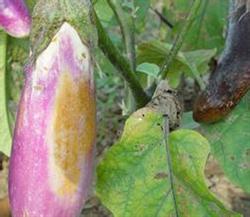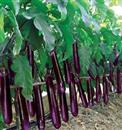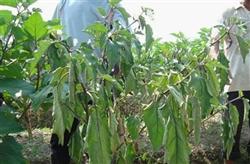How to prevent and cure eggplant cotton blight

Eggplant cotton blight disease, commonly known as rotten fruit and water rot, is one of the important diseases of eggplant, which is common in various places. Eggplant can be harmed at all growth stages. The general loss is 20-30%, and in severe cases, more than 50%. The peak period of the disease is also the peak period of the disease, and disasters often break out in rainy areas and years, resulting in devastating losses. The main results are as follows: 1. the disease identification is mainly harmful to the fruit, and the fruit near the ground first occurs, which is waterlogged at first, and then extends to the whole fruit. The disease spot is slightly sunken, yellowish brown or dark brown, the flesh is dark brown, rotten and easy to fall off. When the humidity is high, dense white cotton-like hyphae grow on the surface of the disease, and the diseased fruit is easy to fall off, or contract into a stiff fruit. It can also infect leaves, stems, flowers and tender stems, forming watery, dark green or purplish brown spots, constricted or broken. When the humidity is high, sparse white mold occurs, and its upper leaves droop. The damaged leaves produce irregular or subrounded watery brown spots with obvious rims. Sparse white mildew grows on the disease spot when it is wet. When the seedlings were killed, the base of the embryo stem showed watery necrosis, causing quenching. Second, the incidence condition of eggplant cotton blight is a fungal disease. The pathogen oospore overwintered in the soil or on the diseased body, and in the second year, the fruits and stems and leaves near the ground were first infected by wind and rain splash, and the sporangia produced on the disease spot were transmitted through wind, rain, irrigation and so on. The plots with high temperature and humidity, sunny weather after rain, excessive plant density, poor ventilation and light transmission, low-lying terrain and heavy soil are easy to occur. Third, control methods 1. Select disease-resistant (tolerant) varieties. Because the resistance of eggplant varieties to cotton blight is very different, it is believed that round eggplant varieties are more resistant than long eggplant varieties. For example, nine-leaf eggplant in Beijing, lantern red in Tianjin, five-star eggplant in Shandong and so on. As the main reason of disease resistance and disease resistance is the smooth fruit surface, it is not easy to leave the conditions for the existence of water droplets and water fog, in the absence of water droplets and water fog, even if there are sporangia, there are no conditions for germination. In addition, thick-skinned varieties were more resistant than thin-skinned varieties, and early-maturing varieties were more resistant than late-maturing varieties. 2. Plastic film mulching. The use of black plastic film to cover the ground or spread between rows can block the spatter transmission of bacterial spores in the soil to eggplant fruit, thus playing a better disease prevention effect. It can also use sunlight to sterilize at high temperature and prevent the growth of weeds. 3. Rotation should be carried out. It is necessary to arrange plots reasonably and avoid continuous cropping with tomatoes, peppers and other Solanaceae and cucurbitaceae crops. Because Phytophthora infestans can not only harm eggplant, but also damage tomato, pepper, potato, cucumber, pumpkin and other crops, generally implement more than 3 years of rotation system. 4. Choose the place carefully. Attention should be paid to the selection of plots with high dryness and good drainage, and the cultivation method of deep ditch and high border should be adopted, which is beneficial to drainage after rain. Prevent low-lying land cultivation and try to avoid the land with heavy soil and easy to accumulate water after rain. 5. Science is rich in water. Apply sufficient mature farm manure, increase phosphorus and potassium fertilizer, timely topdressing, small water fine irrigation without stagnant water, immediately pour clear water after noon rainstorm, in order to resist infection and enhance plant disease resistance. 6. Fine management. Pruning at the right time, remove the lower old leaves, improve the ventilation and light transmission conditions in the field, remove diseased leaves and fruits in time, and take the diseased bodies out of the field to prevent re-infection. 7. Chemical control. Before planting, the eggplant was sprayed with 50% gram carbendazim wettable powder 500 times liquid to spread the seedling bed, and after the slow seedling was planted with medicine, the eggplant was sprayed with 70% zinc wettable powder 500 times liquid to protect it. If the central diseased plant appeared in the initial disease, it should be removed and destroyed immediately and sprayed for prevention and control. Spray protection should be applied during the fruiting period, especially before the rainy season, to prevent the occurrence of diseases. Some farmers from the rainy season, every seven days to spray a spray of Bordeaux liquid 200 times, the effect is very good. Once the disease occurs, the drug must be administered immediately. The medicament has 75% chlorothalonil 500-600 times night, 50% methyl thiophanate wettable powder 800 times, 40% ethyl phosphorus aluminum wettable powder 200 times, 64% poisonous alum 500 times, etc., generally sprayed every 7-10 days, 3-4 times in a row, in order to prevent the formation of drug resistance, different kinds of agents should be used each time.
- Prev

Prevention of misunderstandings in cultivation and Management of protected eggplant
In winter, eggplant is cultivated in facilities, and there are still some misunderstandings in the management process of vegetable farmers, which should be improved. Misunderstanding 1: many vegetable farmers think that in the new shed, there are fewer root-knot nematodes, Verticillium wilt, Fusarium wilt and bacterial wilt, and high yield can be obtained without planting grafted eggplant seedlings.
- Next

Two high-yield techniques for planting eggplant in autumn
Eggplant Verticillium wilt, commonly known as Fusarium wilt, half crazy, black heart disease, is one of the important diseases of eggplant. Generally speaking, the disease begins after the door eggplant sits on the fruit. The disease generally develops from bottom to top or from one side to the whole plant, the leaf veins turn yellow and the leaves wilt. The symptoms were significant at noon at the beginning of the disease, returned to normal in the morning and evening or cloudy days, and the whole plant in the later stage.
Related
- Where is it suitable to grow horseradish in China? it is expected to see the middle altitude horseradish in Alishan.
- How to prevent tomato virus disease reasonably? (Control methods included)
- Many people like to plant towel gourd on the balcony. What are the main points of this method and management?
- What crops can chili peppers be mixed with?
- Fertilization techniques and matters needing attention in Tomato
- What are the grafting techniques for peach seedlings in spring?
- Harm and control methods of root swelling disease of Chinese cabbage
- What are the pests of sweet potatoes? How to prevent and cure it?
- Symptoms, causes and Control methods of navel Rot in Tomato
- The cause of "Cucumber rotten bibcock" in Farmers' planting Cucumber and its Control Plan

